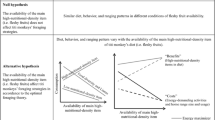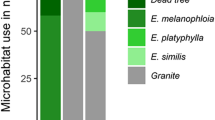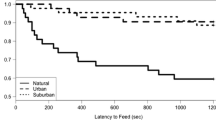Abstract
Tarsiers are considered “vertical clingers and leapers” but there are few empirical data available concerning actual substrate- or space- use patterns in any of the three species. In this paper we examine these patterns in four wild-caught, captive Tarsius bancanusmaintained in large enclosures designed to promote natural behavior. We find that this species uses space in a distinctly nonrandom manner, exhibiting a preference for midlevel heights and upright, small-diameter substrates. The observed space-utilization pattern was best explained by strong preferences for specific heights and not by the distribution of prey items, preferred substrate types,or substrate angles. Unlike wild T. bancanus,which reportedly forage consistently on the ground, these tarsiers did not forage on the floor of the enclosures despite the abundance of food there.
Similar content being viewed by others
References
Cartmill, M. A. (1974). Pads and claws in arboreal locomotion. In Jenkins, F. A. (ed.),Primate Locomotion, Academic Press, New York, pp. 45–83.
Charles-Dominique, P. (1974). Ecology and feeding behaviour of five sympatric loriside in Gabon. In Martin, R. D., Doyle, G. A., and Walker, A. C. (eds.),Prosimian Biology, Duckworth, London, pp. 135–150.
Cook, N. (1939). Notes on captiveTarsius carbonarious.J. Mammal. 20: 173–177.
Cunningham, B. C. (1984). Habitat preference in house crickets, (Acheta domesticus).Anim. Keep. Forum II: 342–344.
Dance, D. (ed.), (1983).Mathematical and Statistical Programs. Smithsonian Institution Office of Information and Resource Management, Scientific Applications Division, Washington, D.C. (unpublished).
Day, M. H., and Iliffe, S. R. (1975). The contrahens muscle layer inTarsius.Folia primatol. 24: 241–249.
Dykyj, D. (1980). Locomotion of the slow loris in a designed substrate context.Am. J. phys. Anthropol. 52: 577–586.
Fogden, M. P. (1974). A preliminary field study of the western tarsier,Tarsius bancanus Horsfield. In Martin, R. D., Doyle, G. A., and Walker, A. C. (eds.),Prosimian Biology, Duckworth, London, pp. 151–166.
Grand, T. I., and Lorenz, R. (1968). Functional analysis of the hip joint inTarsius bancanus (Horsfield, 1821) andTarsius syrichta (Linnaeus, 1758).Folia primatol. 9: 161–181.
Harrison, B. (1963). Trying to breedTarsius.Malay Nat. J. 17: 218–231.
Hill, W. C. O. (1953). Caudal cutaneous specilaizations inTarsius.Proc. Zool. Soc. Lond. 123: 17–29.
Jouffroy, F. K., and Gasc, J. P. (1974). A cineradiographical analysis of leaping in an African prosimian (Galago alleni). In Jenkins, F. A. (ed.)Primate Locomotion, Academic Press, New York, pp. 117–142.
Lewis, G. (1939). Notes on a pair of tarsiers from Mindanao.J. Mammal. 20: 57–61.
MacKinnon, J., and MacKinnon, K. (1980). The behavior of wild spectral tarsiers.Int. J. Primatol. 1: 361–379.
Napier, J. R., and Walker, A. C. (1967). Vertical clinging and leaping —a newly recognized category of locomotor behaviour in primates.Folia primatol. 6: 204–219.
Nie, N. N., Hull, C. H., Jenkins, J. G., Steinbrenner, K., and Bent, D. H. (1975).Statistical Package for the Social Sciences, McGraw-Hill, New York.
Niemitz, C. (1979a). Outline of the behavior ofTarsius bancanus. In Doyle, G. A., and Martin, R. D. (eds.),The Study of Prosimian Behavior, Academic Press, New York, pp. 631–660.
Niemitz, C. (1979b). Relationships among anatomy, ecology and behavior: A model developed in the genusTarsius, with thoughts about phylogenetic mechanisms and adaptive interactions. In Morbeck, M. E., Preuschoft, H., and Gomberg, N. (eds.),Environment, Behavior and Morphology: Dynamic Interactions in Primates, Gustav Fischer, New York, pp. 119–137.
Niemitz, C. (1979c). Results of a field study on the western tarsier (Tarsius bancanus borneanus Horsfield, 1821) in Sarawak.Sarawak Mus. J. 27: 171–228.
Niemitz, C. (1984a). Activity rhythms and use of space in semi-wild Bornean tarsiers, with remarks on wild spectral tarsiers. In Niemitz, C. (ed.),Biology of Tarsiers, Gustav Fischer Verlag, Stuttgart, pp. 85–115.
Niemitz, C. (1984b). Locomotion and posture ofTarsius bancanus. In Niemitz, C. (ed.),Biology of Tarsiers, Gustav Fischer Verlag, Stuttgart, pp. 191–225.
Pocock, R. I. (1918). On the external characters of the lemurs and ofTarsius.Proc. Zool. Soc. Lond. 1918: 19–53.
Preuschoft, H., Fritz, M., and Niemitz, C. (1979). Biomechanics of the trunk in primates and problems of leaping inTarsius. In Morbeck, M. E., Preuschoft, H., and Gomberg, N. (eds.),Environment, Behavior and Morphology: Dynamic Interactions in Primates, Gustav Fischer Verlag, New York, pp. 327–345.
Reason, R. (1978). Support use behavior in Mindanao tarsiers (Tarsius syrichta carbonarius).J. Mammal. 59: 205–206.
Roberts, M., and Baker, A. (1985). Foraging behavior in the western tarsier,Tarsius bancanus in captivity. Abstr. Am. Assoc. Mammal. 65th Ann. Mtg., Orono, Maine, p. 33.
Roberts, M., Kohn, F., Keppel, A., Maliniak, E., and Deal, M. (1984). Management and husbandry of the western tarsier,Tarsius bancanus, at the National Zoological Park.AAZPA Region. Proc. 1984: 588–600.
Schreiber, G. R. (1968). A note on keeping and breeding the Phillipine tarsier,Tarsius syrichta, at Brookfield Zoo Chicago.Int. Zoo Yb. 8: 114–115.
Sokal, R. R., and Rohlf, F. J. (1973).Introduction to Biostatistics, W. H. Freeman and Co., San Francisco.
Sprankel, H. (1965). Untersuchungen anTarsius. I. Morphologie des Schwanzes nebst ethologischen Bemerkungen.Folia primatol. 3: 153–188.
Ulmer, F. A. (1963). Observations on the tarsier in captivity.Zool. Gart. 27: 106–121.
Wharton, C. H. (1950). The tarsier in captivity.J. Mammal. 31: 260–268.
Zar, J. H. (1974).Biostatistical Analysis, Prentice-Hall, Englewood Cliffs, N.J.
Author information
Authors and Affiliations
Rights and permissions
About this article
Cite this article
Roberts, M., Cunningham, B. Space and substrate use in captive western tarsiers,Tarsius bancanus . Int J Primatol 7, 113–130 (1986). https://doi.org/10.1007/BF02692313
Received:
Revised:
Issue Date:
DOI: https://doi.org/10.1007/BF02692313




